Introduction
While considered one of the ancient mythologies in the world, Hindu mythology is distinct from its other historical counterparts. That is because the extensive scope of Hindu deities, unlike Mesopotamian, Egyptian and Greek mythologies, still has its current effect on the diverse socio-religious circles of present-day India.
As for history, the first mention of the various Hindu gods and goddesses is found in the Vedic literature that alludes to their Indo-European origins. However, over time, like many other comparable ancient pantheons, these Hindu deities, their narratives, and their associated aspects have evolved or had been completely altered with the passage of time.
This mirrors the dynamic and multifaceted transition from the early Vedic civilization to what we know as the present-day Indian civilization and the Hindu faith (in the form of organized religion). Taking these factors into consideration, let us take a gander at 15 major ancient Hindu (Indian) gods and goddesses you should know about.
Contents
- Introduction
- Early Vedic Hindu Gods and Goddesses –
- Post-Vedic Hindu Gods and Goddesses –
- Saraswati – The Goddess of Knowledge
- Brahma – The Creator Among The Supreme Triad
- Vishnu – The Preserver Among The Supreme Triad
- Shiva – The Destroyer Among The Supreme Triad
- Shakti – The Goddess of Power
- Durga – The Demon-Slaying Warrior Goddess
- Kali – The Goddess of Destruction
- Ganesha – The God of Intellect and Arts
- Lakshmi – The Goddess of Auspiciousness
- Kartikeya – The Herald of Heaven
- Family Tree of Hindu Gods and Goddesses –
Early Vedic Hindu Gods and Goddesses –
Indra – the King of Devas
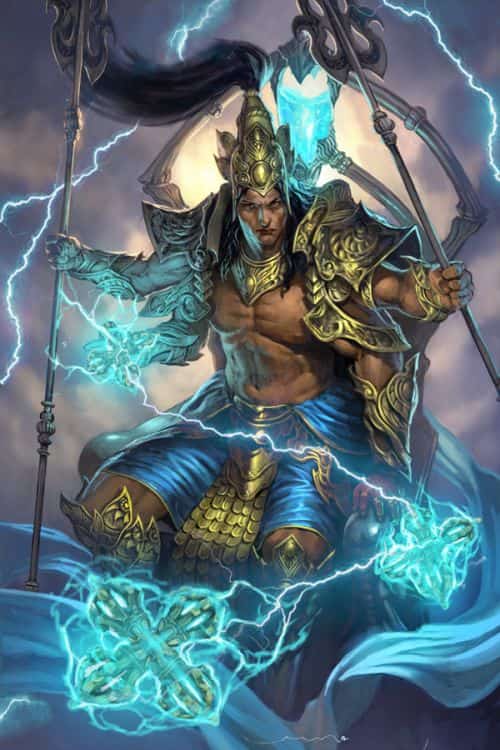
Indra was the most important Hindu deity in the pantheon of Vedic mythology (along with Buddhist and Jain pantheons), and as such is still counted as a significant deity among the present-day Hindu gods and goddesses.
Alluding to the Indo-European roots of early Vedic religion, Indra (also known as Devendra) is often perceived as the Indian counterpart to European deities like Zeus, Perun, and even Odin and Thor.
Indra is venerated as the king of the Devas (benevolent divine beings) who symbolized the aspects of thunder, storms, rains, and the flow of rivers. By virtue of his stature among the early Hindu gods, Indra mounts on his imposing white elephant Airavata and arms himself with his thunderbolt Vajra.
He also commands the heavenly Devas host (who dwells on the Swarga or Svarga Loka or heaven) against their adversaries – the malevolent demonic entities known as the Asuras.
As for the Indian Hindu creation myth, Indra – the leader of the Devas, was born, from Purusha, a masculine primordial entity. And given his numerous heroic exploits in the mythical narrative, Indra is also called the Vrtrahan (‘the slayer of the serpent demon Vritra’) and is noted as the father of Arjuna, one of the heroes of the Indian epic Mahabharata.
However, over time, the narrative also tends to portray the ‘negative’ characteristics of the warrior king of the gods, like his penchant for the intoxicating soma drink and amorous activities related to other people’s wives.
In post-Vedic literature, he is even ridiculed on occasions pertaining to his flighty behavior. This shift in narrative alluded to the rising prominence of other Hindu gods, like the Trimurti – the Hindu trinity of gods (discussed later in the article).
Agni – The Fire God
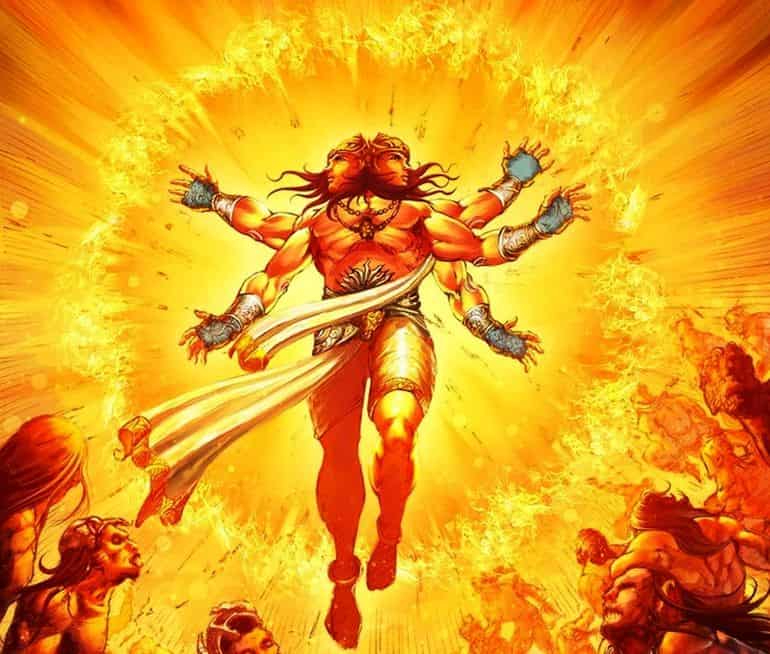
Agni – the literal Sanskrit term for fire, is the major deity of fire among the ancient Hindu gods and goddesses. To that end, it has been hypothesized that Agni was possibly the second most important of early Hindu deities (after Indra), as suggested by the number of hymns dedicated to him in the Rig Veda.
Interestingly enough, fire is still central to the theme of the Hindu religion, with its crucial role in the various yajnas (rites). And even beyond his aspect of fire in the earthly domain, Agni symbolized other forms of energy in the ‘atmosphere’, including both lightning and the sun.
Furthermore, Agni was/is also regarded as the divine medium that accepts the sacrifices (made during yajnas) to the Hindu gods, thus essentially alluding to his early role as the ‘connection’ or messenger between other divine beings.
Over time, the scope of Agni, rather than a physical manifestation of a fire god, is regarded more as a presentation of transformative energy that is internalized. However, the role of fire still remains important in Hindu culture, ranging from the various festivities and rituals, like Diwali and marriage ceremonies.
Surya – The Sun God
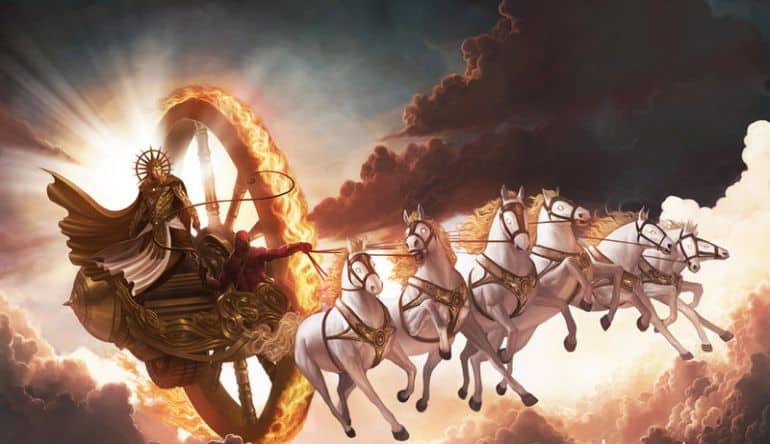
Surya – the literal Sanskrit term for the sun, is the major solar deity among the Hindu gods and goddesses. Also known by synonymous epithets like Aditya, Ravi, and Bhaskara, the Sun God is revered as the sustainer of life (prakriti) in the Vedic literature, dating from circa 1500-1000 BC.
Interestingly enough, in spite of being one of the older Hindu deities of Indian mythology, his creation myth often takes the complex route. One narrative suggests how he was the son of Dyaus (sky), while another hints at how he was sired by Kasyapa (a Vedic sage) and Aditi (the ‘limitless’ mother of the gods).
In any case, befitting his status as the effulgent sun, Surya is often portrayed in a resplendent manner as a mighty figure seated atop an ostentatious chariot – drawn by seven horses and driven by Aruna, the personification of dawn.
But as was the fate of most early Vedic Hindu gods and goddesses, Surya was later identified with and made a composite of other important Hindu gods like Vishnu (their composite form is known as Surya Narayana in the Yajur Veda).
In the mythical narrative, the ‘demotion’ is somewhat mirrored by the clipping of Surya’s immense power, whose blazing shards were used for making destructive ‘godly’ weapons used by other Devas (such as the trident of Shiva and the lance of Karthikeyan).
However, unlike some of his early Vedic brethren, Surya is still held in very high regard in modern-day Hinduism, as can be gathered from Surya Namaskar, an ancient technique of sun salutation that is used in various Yoga regimens.
Varuna – The God of Sky and Oceans
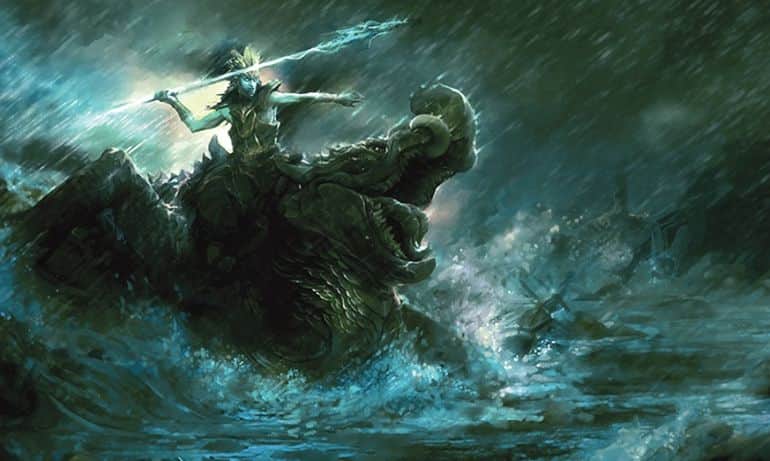
Varuna (‘he who encompasses’) is an enigmatic Hindu god (or Vedic entity) among the early Hindu deities, who was first associated with the sky. He later symbolized the forces of oceans, clouds, and water. Pertaining to the latter, he is often depicted with his vehicle, the Makara – a hybrid sea creature that is often found in other ancient Indian motifs.
However, beyond the scope of skies and oceans, Rig Veda also mentions how Varuna is the guardian of the moral law encompassing both Rta (justice) and Satya (truth). In that regard, the god serves his dual role as the ruthless punisher of the sinners and the compassionate forgiver of the remorseful.
Varuna is sometimes also twinned with the god Mitra, and together the (composite) Mitra-Varuna are revered as the gods of oaths and societal affairs. Quite intriguingly, a few scholars have put forth their hypothesis that Varuna was among the oldest of the Indo-Aryan gods, circa 2nd millennium BC. The figure may have even given way to Rudra (‘the roarer’), the Vedic Hindu god of wind, storm, and hunt.
As for the mythical narrative, Rig Veda does make mention of Varuna as both an Asura (demonic being) and a Deva (heavenly being). This suggests that Varuna may have been adopted as a Deva after the defeat of Vritra and the altering of the cosmic order by Indra.
Yama – The God of the Underworld and Death
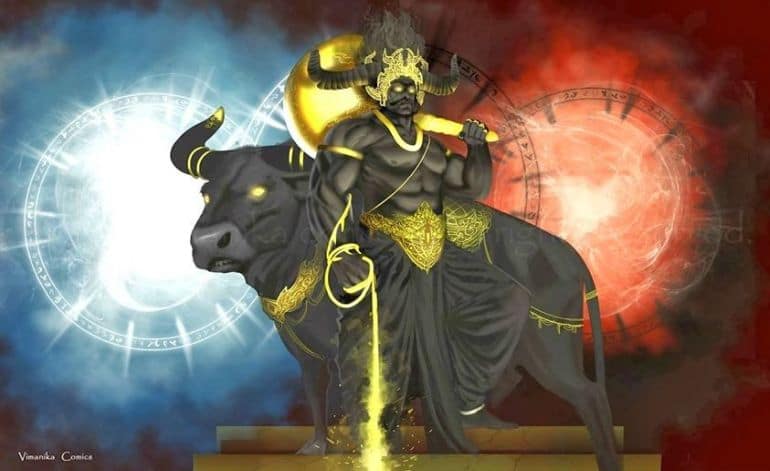
Yama is the deity of death and the underworld among the most important Hindu gods and goddesses (and also the Buddhist pantheon). He was/is venerated as the patron god of the ancestors and the divine judge of the departed souls.
Also known by his other monikers Dharmaraja (‘ruler of justice’) and Mrityu (‘death’), Yama is mentioned in the Vedas as being the first mortal who died (thereby providing him with the precedence to rule over his departed brethren).
However, in Vishnu Purana, he, along with his twin sister Yami, is extolled as the son of Vivasvat (an aspect of Surya), the resplendent sun god of the Hindu mythology, and Saranyu-Samjna, the Hindu goddess of conscience.
Interestingly enough, unlike some other ‘ruthless’ deities of death in various mythologies, Yama is often (though, not always) portrayed as a thoughtful entity who goes through all the just and due processes to judge the fate of a human soul.
Often aided by his trusty scribe Chitragupta and his register Agrasandhani (that records the deeds of the judged person), Yama has the power to offer either immortality to the soul (which then resides in content under the patronage of Yama) or offer rebirth (thus suggesting another chance at leading a good life).
On the other hand, Yama can also decide to condemn a soul, which, according to the mythical narrative, is then banished down into the 21 levels of hell (the lower the strata, the worse the fate). As for his depiction, Yama was/is often portrayed with his dark green (or blue) skin, carrying his rod (made from a fragment of Surya), and riding atop a buffalo.
Post-Vedic Hindu Gods and Goddesses –
Saraswati – The Goddess of Knowledge
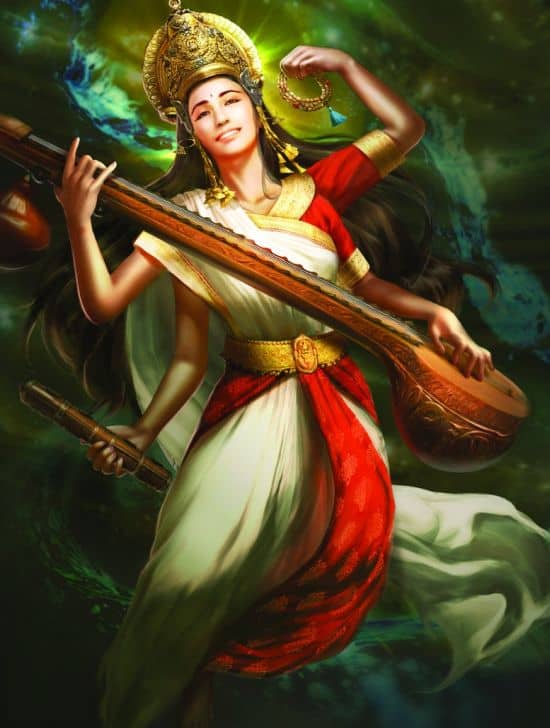
Saraswati (or Sarasvati – ‘she who possesses water or [later] speech’) is the feminine deity of wisdom, art, music, knowledge, and writing (alphabet). Her worship is considered essential among the most important Hindu gods and goddesses. In fact, she started out as an early Vedic goddess who symbolized the aspect of rivers and mothers, essentially pertaining to her powers of healing and purifying.
These powers are rather espoused by her white (and rather austere) attire, bereft of bright colors and ostentatious jewelry. Along similar lines, the later Indian religious and secular texts mention how virtue, at its core, is an aspect of Saraswati. The qualities of ancient wisdom and eloquence are also associated with Saraswati (or Bharati).
And in spite of her older Vedic origins, Saraswati was highly regarded in the later Hindu texts and rites. To that end, she is often counted among the Tridevi (three major Hindu goddesses – Parvati, Lakshmi, and Saraswati, who are female counterparts to the three major male Hindu gods).
Usually depicted with four hands that mirror the appendages of her husband Brahma (discussed later in the article), Saraswati carries her range of items steeped in symbolism – pustaka (book), mala (garland), and bina (a musical instrument); and is often accompanied by a swan epitomizing purity.
Brahma – The Creator Among The Supreme Triad
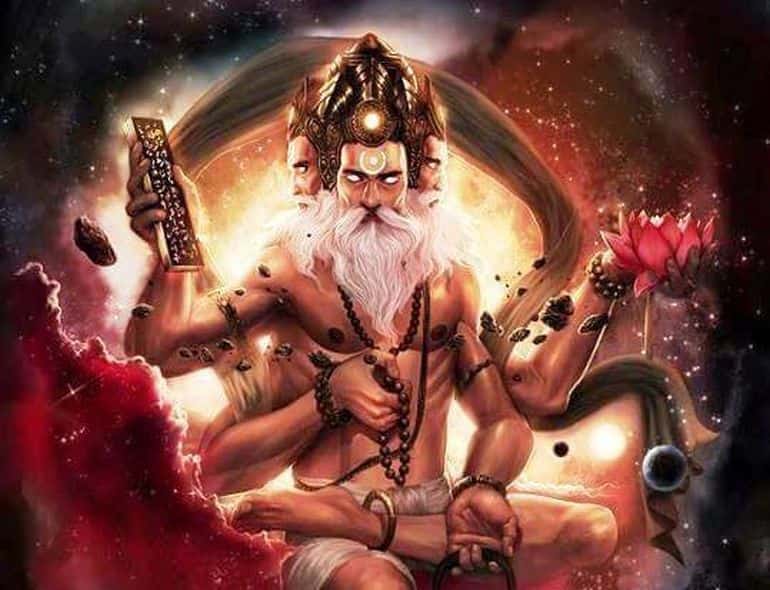
Brahma is one of the Trimurti – a trinity of major Hindu deities that forms the core of the Indian pantheon starting from the post-Vedic period to the present day. Also known by his names Svayambhu (the ‘self-born’) and Gyaneshwar (‘the lord of knowledge’), Brahma, in the mythical narrative, was/is said to have created the cosmos and order with his life essence.
Puranas (post-Vedic literature) mention how he was born from a lotus (related to the navel of Lord Vishnu). Brahma is often also perceived as an aspect of metaphysical reality in the Upanishads that goes beyond the traditional limit of morphology (or personification) associated with mythical beings.
Talking of Vedic literature, Brahma is sometimes equated to Prajapati, an early Vedic deity that had its fair share of evolving roles in Hindu mythology. As for Brahma’s physical characteristics, the god is depicted as an old, wise man (like ancient saints) with four heads – possibly alluding to the creation of the four Vedas.
And while he is one of the members of the aforementioned Trimurti, there are very few Hindu temples in India that are dedicated to Brahma. According to many scholars, this might relate to how his role as a creator has been overtaken by other Hindu gods tasked with preservation and rebirth.
Vishnu – The Preserver Among The Supreme Triad
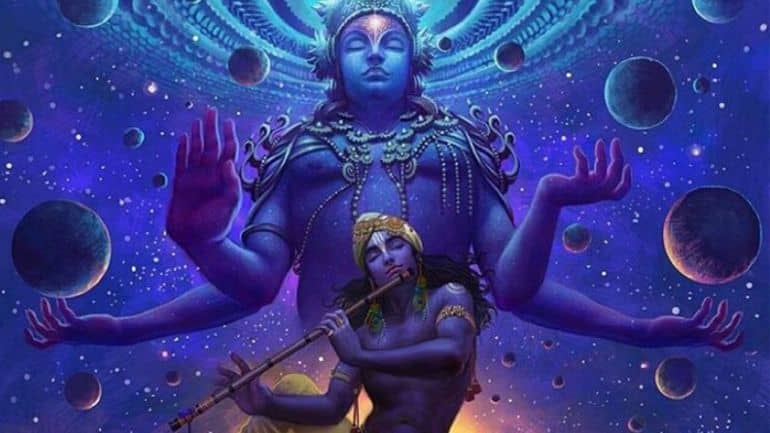
Vishnu (counted as one of the Trimurti or Hindu trinity of gods) is one of the principal deities among the various Hindu gods and goddesses – who is associated with the role of preservation of the universe (or its metaphysical counterpart Brahman). Essentially, he is widely revered as the ‘preserver’ or ‘protector’ of the ordered cosmos, with the latter role often pertaining to the Hindu concept of Avatars.
The Avatar (‘descent’) concept relates to the incarnation of the deity in the material world, whose duty mostly lies in aiding humanity and purging evil from the world. In that regard, Vishnu is said to have ten Avatars (Dashavatar), with the last avatar Kalki yet to be born.
In terms of Hindu mythology, the first avatar Matsya (in a fish form) helped Manu, the progenitor of humanity, to escape a catastrophic flood (thus alluding to the ancient deluge trope), while the seventh avatar – the eminent hero Rama is portrayed as slaying the demon-king Ravana (in the Indian epic Ramayana).
Also, the words and wisdom of the eighth avatar Krishna form the basis for the Bhagavad Gita – one of the significant sacred texts of Hinduism. Interestingly enough, the Bhagavad Gita is just a chapter from the Indian epic Mahabharata – the world’s longest poem that is roughly 10 times the length of the Illiad and Odyssey combined.
Suffice it to say, Vishnu, also known by his other names Narayana, Jagannath (the origin of the term ‘juggernaut’), and Hari, plays a crucial role in the mythos of many Hindu gods and goddesses. In fact, he is considered the supreme god (among the major deities) by the Vaishnavi sect of Hindus.
As for his iconography, Vishnu is depicted in his characteristic pale blue skin, holding a lotus, mace, discus, and conch in each of his four hands. Concurrently, Krishna, his eighth avatar, is also depicted with similar attributes.
And quite intriguingly, from the perspective of history, Vishnu, while mentioned in the Rig Veda, only gained precedence over other deities (like Indra) in the later stages of the post-Vedic period – thus mirroring the transition from the early Vedic religion to present-day Hinduism.
Shiva – The Destroyer Among The Supreme Triad
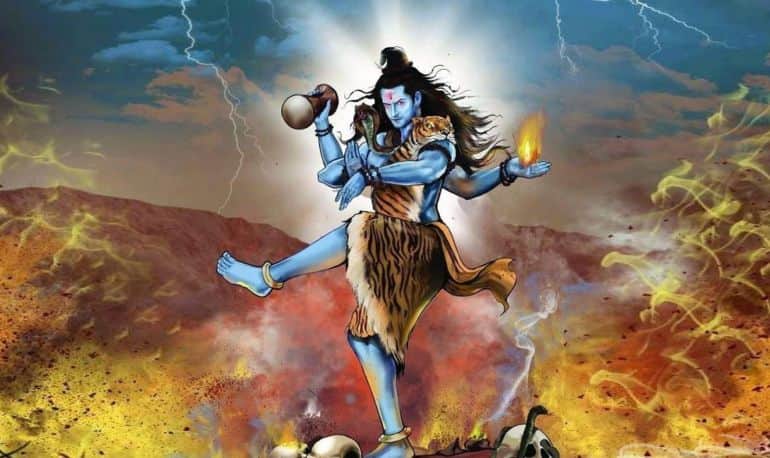
Shiva (the third member of the Trimurti Hindu trinity) is associated with the perplexing concept of time and thus plays his contradictory role in the imminent destruction (or death) and regeneration of the cosmos.
In essence, god Shiva, also known as Mahadeva (the Supreme God – among Hindu deities), plays the benevolent role of creating and protecting the ‘good’, while also demonstrating his unmatched anger in destroying the ‘evil’, which in itself alludes to the duality of nature.
Pertaining to the former, the god Shiva does play an essential role in siring a number of other important Hindu deities, including Ganesha and Karthikeyan (discussed later in the article). Furthermore, his consort Parvati is often incarnated as powerful female entities like the magnificent Durga and the ruthless Kali to fight the evil Asuras and demons.
Now much like the abstract associated with the other members of the Trimurti (three deities), the god Shiva is sometimes also widely revered as a limitless and transcendent entity that encompasses both chaos and order. Consequently, his vigorous (and even cataclysmic) dance of Tandava signifies the cycle of creation, preservation, and dissolution.
As for his iconography, the god Shiva is often depicted as the divine ascetic with his matted hair, unkempt appearance, the Vasuki snake coiled around the neck, and a trident (trishul). And while Shiva prefers his deep meditations atop the remote Kailash mountain, he also commands the power of agni (fire) for destruction and damaru (drum) that heralds creation.
Shakti – The Goddess of Power
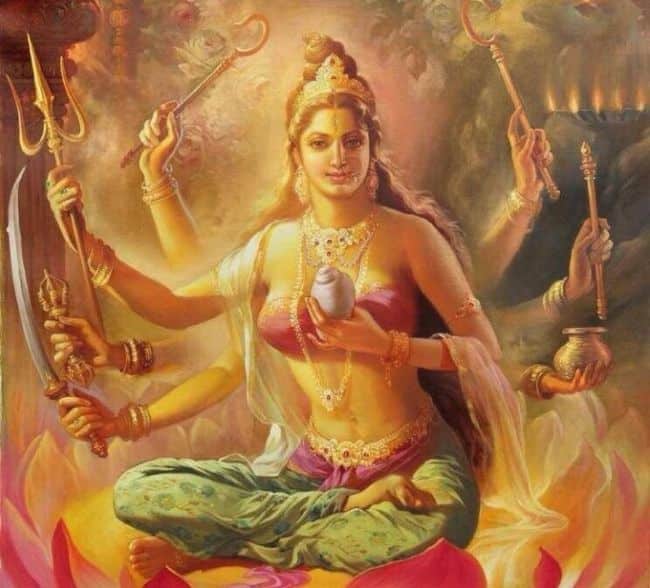
Shakti literally translates to power or might in Sanskrit. Her divine essence is venerated as the manifestation of the primordial cosmic energy. Given the association to creation (or birth) on an elemental level, Shakti is often considered feminine in form and is thus given the epithet of ‘The Great Divine Mother’.
Her mother form, also known as Adi Shakti or Adi Parashakti (‘supreme energy’) is not only equated to creation but also extolled as the bringer (or agent) of change.
In terms of Hindu mythology, Shakti is often viewed as the feminine energy reserved within Shiva. In other words, she epitomizes the creative power of Shiva (often identified as his consort and lover Parvati). As such eight other mother goddesses represent the Shakti (power) of their male counterparts.
Shakti is also worshipped as Tripura Sundari or simply Devi (goddess) – the eternal feminine entity (or even mother goddess) whose essence is found in numerous manifestations, ranging from might (Durga), and knowledge (Saraswati) to wealth (Lakshmi). To that end, the Shakta sect of Hindus regards Shakti or Devi as the Supreme Being that encompasses the feminine force of metaphysical reality.
Durga – The Demon-Slaying Warrior Goddess
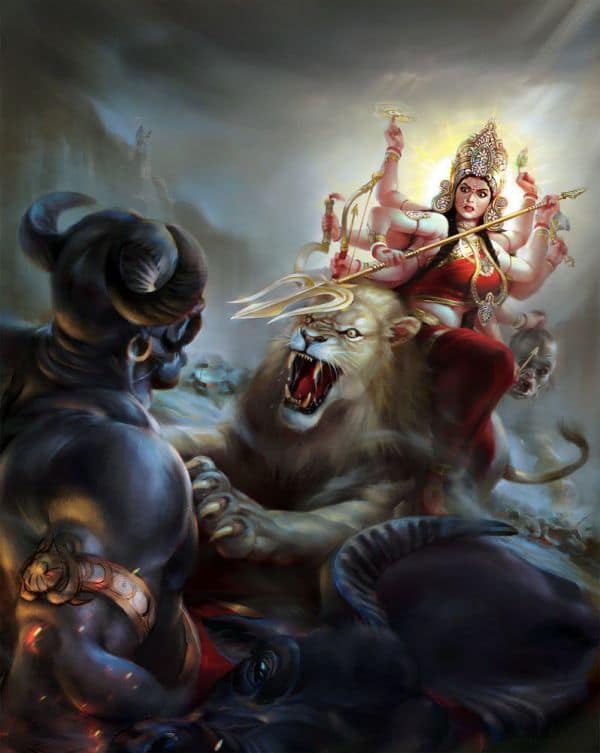
Durga is widely revered as a magnificent manifestation of Shakti (or Parvati). She is one of the principal feminine deities among the important Hindu gods and goddesses. Also known by her other names, including Amba, Bhavani, and the ubiquitous Devi, Durga (relating to a fortress, literally meaning ‘invincible’ or ‘unassailable’) is venerated as a warrior goddess tasked with vanquishing evil and thus protecting the scope of peace and prosperity.
A popular mythical figure in India, the first mention of Durga (or Durgi) was found in Rig Veda, though her narrative was formulated in later Hindu folklore and literature. According to this post-Vedic narrative, the feminine Durga was created by the combined Shakti (divine feminine essence) of the Trimurti (Brahma, Vishnu, and Shiva).
Many Hindu gods (Devas) also provided their aid to this crucial task. The divine purpose entailed battling and defeating Mahishasura, the evil demon who was emboldened by the boon that no man (or male) could kill him.
And thus Durga strides forth atop her lion, attired in splendid dress and armor and armed with a thousand powerful weapons (held in her thousand hands) offered by the other gods from Swarga (paradise). In the mythical narrative, she achieves her goal with aplomb and is thus extolled as the demon-slaying goddess Mahishasuramardini (‘the slayer of Mahishasura’).
As for the historical perspective, this popular trope of Durga defeating her nemesis and delivering the world from evil was possibly already established by circa 6th century AD, as suggested by epigraphical inscriptions in the early Siddhamatrika script.
Kali – The Goddess of Destruction
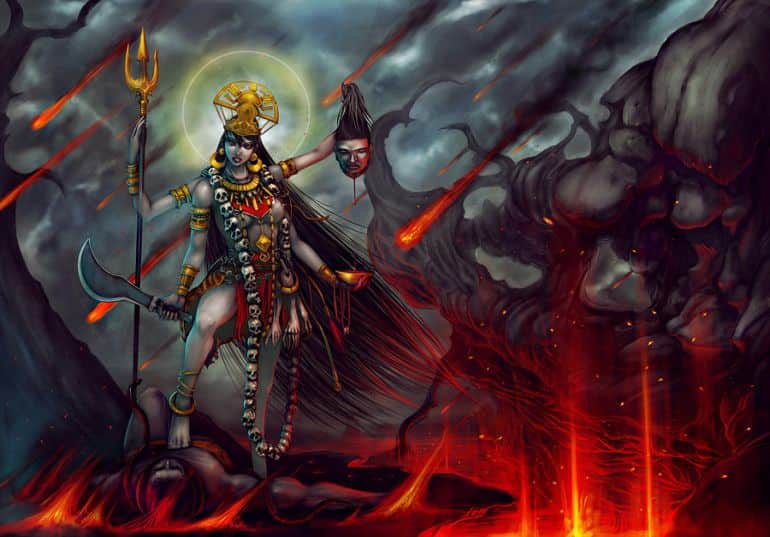
While Durga espouses the magnificence of Shakti, Kali, among the Hindu gods and goddesses, represents the violent nature of Shakti (power). In the feminine form of Kalam (meaning dark colored or dark blue), Kali is often portrayed as one of the incarnations of Parvati’s skin (which the goddess sheds). Another famous legend even mentions her as the manifestation of the destructive power of Durga herself.
This particular mythical narrative talks about how Kali issued forth from the forehead of Durga after the latter (along with her helpers Matrikas) was flummoxed by one Asura demon named Raktabija – who cloned himself from every drop of blood that fell on the ground. The Hindu text Devi Mahatmyam (written circa the 6th century AD) describes the daunting nature of Kali –
Out of the surface of her (Durga’s) forehead, fierce with frown, issued suddenly Kali of terrible countenance, armed with a sword and noose. Bearing the strange khatvanga (skull-topped staff), decorated with a garland of skulls, clad in a tiger’s skin, very appalling owing to her emaciated flesh, gaping mouth, fearful with her tongue lolling out, having deep reddish eyes, filling the region of the sky with her roars, falling upon impetuously and slaughtering the great asuras in that army, she devoured those hordes of the foes of the devas.
The rampage of Kali was/is a popular motif in the Hindu religion, and as such, the violent goddess is often venerated by the cremation grounds (usually associated with battlefields). As for history, while Kali is mentioned in the Atharva Veda and later Upanishads, her prominence as a goddess figure among the Hindu gods possibly came after the 6th century AD.
Ganesha – The God of Intellect and Arts
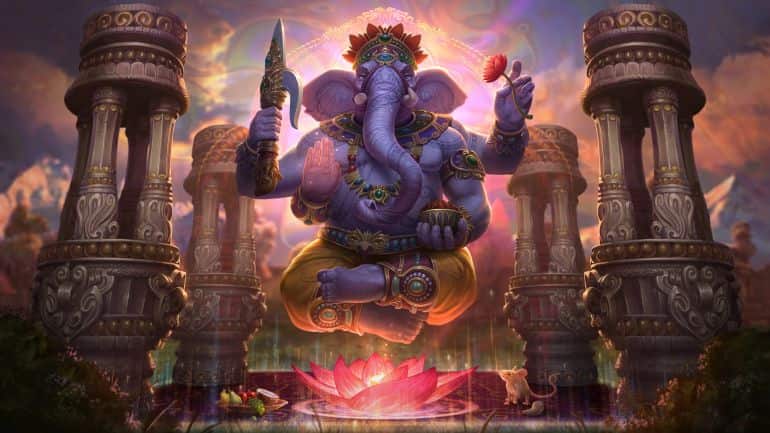
One of the popular deities among the most important Hindu gods and goddesses, Ganesha, also known as Ganapati and Vinayaka, is visually conspicuous by virtue of his elephant head. In the mythical narrative, he is the son of Shiva and Parvati, and as such is usually depicted as a jovial deity with a pleasant personality and plump physical attributes.
To that end, Ganesha is often venerated as the patron god of intellect, letters, arts, and sciences who is also responsible for creating the order and classes of men (Ganapati meaning ‘lord of classes’). As for his distinct ‘elephant’ head, the popular myth relates to how Shiva unknowingly struck down his originally human head
The violent act was committed after the supreme god was denied access to his own abode by Ganesha on account of the latter’s guarding duty when Parvati was bathing. However, the remorseful Shiva later learning of his son’s identity replaced the part with that of a powerful elephant’s head.
On the historical side of affairs, like many of the other major Hindu gods and goddesses, Ganesha (or at least Ganapati) was mentioned in the Rig Veda (his name also appears in the Buddhist tantras).
However, the evolution of the deity, along with his discernible elephant form, was possibly developed by the 6th century AD. Moreover, by the 10th century AD, Ganesha was favored by the Indian merchants and traders who established distant trade networks across the subcontinent and Southeast Asia.
Lakshmi – The Goddess of Auspiciousness
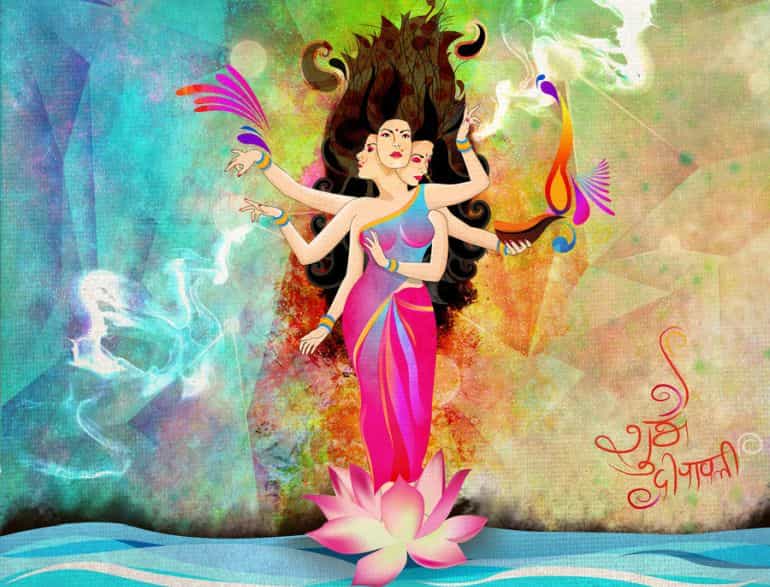
Lakshmi is a major deity of wealth, good fortune, and prosperity among the most important Hindu gods and goddesses She is often depicted as the consort (as well as Shakti) of Vishnu. In the mythical narrative, Lakshmi was born from the churning of the primordial ocean (a process known as the Samudra Manthan). After emerging from the vigorous water she chooses Vishnu as her eternal companion.
Consequently, this ties her up with the fate of Vishnu, thereby also allowing her to take up forms of female Avatars who could accompany the male Avatars of her husband.
Furthermore, on the symbolic level, Lakshmi, also known as Sri, represents the divine and auspicious qualities of her companion. This evokes the strength of a relationship between a husband and wife (pertaining to the latter, Lakshmi is often venerated during Hindu marriage ceremonies).
As for her aspects focused on fortune, wealth, and auspiciousness, the famous Indian festival of Diwali is celebrated in the veneration of Lakshmi. And coming to the scope of history, interestingly enough, in early Vedic religion, Lakshmi was regarded as the symbol (or mark) of good fortune that is associated with the birth of every mortal.
Over the course of time (circa 1st century AD), the symbolism was personified as a gracious, charming, and sovereign feminine deity associated with the fortuitous essence of Shakti.
Kartikeya – The Herald of Heaven
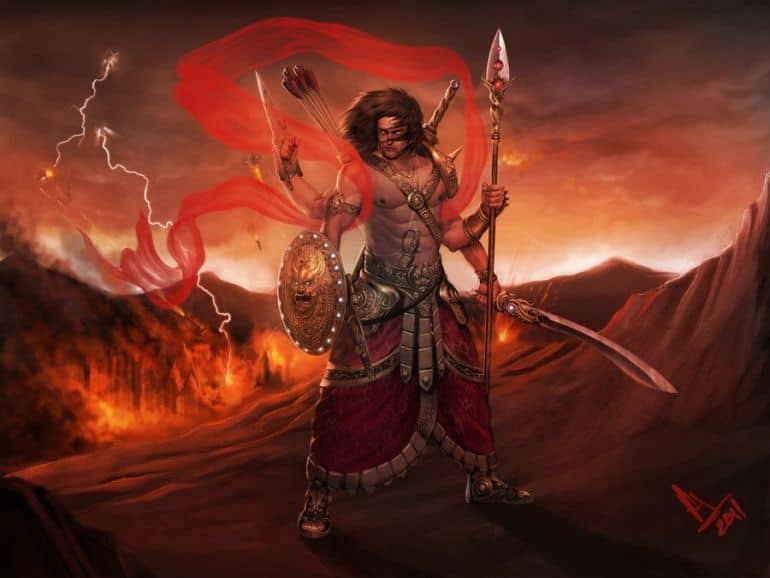
Kartikeya, the eternally youthful deity among the Hindu gods and goddesses, is also known as Kumara, Skanda, and Murugan (‘the youth’). The latter is an important deity among the Tamil people residing not only in India but also in other parts of the world, including Sri Lanka, Singapore, Mauritius, Indonesia, and Malaysia.
In the mythical narrative, Kartikeya is often portrayed as the son of Shiva and Parvati, with one legend mentioning how Kartikeya was incubated in Ganga (preserved by the heat of Agni) after Shiva accidentally spilled his semen while making love to Parvati.
The resplendent nature of the child caught the attention of the Krittikas, feminine entities who wanted to shower their motherly love – and thus these Krittikas, symbolized by the seven brightest stars of the Pleiades cluster, gave their collective name to the child – Kartikeya (‘of the Krittikas’).
When it comes to the depiction, Kartikeya (or his Murugan aspect), seated on his peacock, is often dressed in royal attire and armor, while carrying his range of weapons, including his powerful spear Vel (on occasions, he is also depicted with six heads – Shanmukha).
The visual motifs and the complementing narratives usually portray Kartikeya as the Hindu (philosophical) god of war, who while commanding the heavenly host, defeated the mighty demonic Asura Taraka.
As for history, while some versions of Kartikeya (like Kumara) do appear in the early Vedic literature (pre-1000 BC), it is possible that the deity gained prominence only after the 3rd century BC – evident from the Indian epics and Sangam literature.
Family Tree of Hindu Gods and Goddesses –

Featured Image Credit: Artwork by Nisachar (DeviantArt)
And in case we have not attributed or misattributed any image, artwork, or photograph, we apologize in advance. Please let us know via the ‘Contact Us’ link, provided both above the top bar and at the bottom bar of the page.
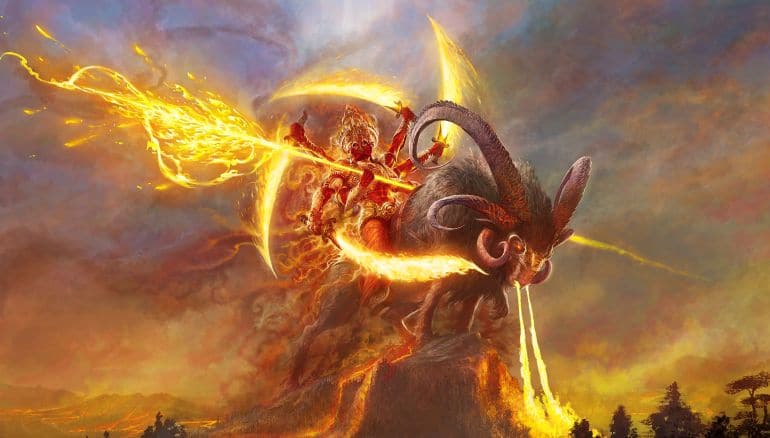

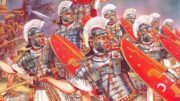

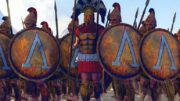
Be the first to comment on "15 Awe-Inspiring Hindu Gods and Goddesses You Should Know About"